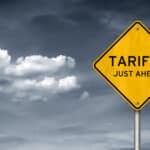Solving the Deglobalization/Globalization Paradox
I’ve talked a lot about how organizations must redesign their end-to-end supply chain. But where do you start with your entire global network?
How about at the beginning? Nobody produces anything without natural resources. Sourcing and procurement are key. And in an age of simultaneous deglobalization and globalization, your enterprise should view the world as your procurement department.
Taking that into account, your redesigned global network could:
- Send some raw materials from Africa to manufacturers in South America.
- Source some raw materials in the Philippines, Indonesia and Malaysia.
- Source some raw materials in India.
- Source some manufacturing in Southeast Asia, some in Africa, some in India.
- Source raw materials and manufacturing in the United States, Canada and Europe.
- Any combination of the above, or any combination you can imagine. True optionality.
After all, no country will produce everything its population needs. Although many have paid lip service to such fantasies in the past and present. This was common in previous eras of deglobalization.
China’s Position in Global Markets
It’s no secret that global supply chain leaders are looking to decouple from China. Many think supply chains start there because China dominates the world’s natural resources. Actually, China ranks sixth globally behind Russia, the United States, Saudi Arabia, Canada, and Iran.
China’s end-to-end supply chain heavily relies on other countries for resources like iron ore and refined copper. For instance, in 2022, nearly 70% of the world’s lithium came from Australia and Chile.
However, China has been proactive in securing access to raw materials. Australia exports almost all its lithium to China. And China is the world’s third-largest producer of that silvery, alkali metal. A Chinese state-owned company is the largest shareholder in Australian mining giant Rio Tinto.
China also dominates the rare earth minerals market, crucial for green energy transition. China produces 98% of the world’s gallium, a critical component in advanced defense technology. And the Chinese government has shown it will use flex that market dominance. It recently restricted exports of gallium and germanium, key semiconductor materials.
Scanning the Globe for New Supplier Selection
The rest of the world is trying to catch up. The conflict between Russia and Ukraine has disrupted oil and gas exports to Europe. The European Commission responded by turning to South America, aiming to develop value-added lithium projects in Chile.
New resources outside of China are crucial. The Western U.S., for instance, could hold the world’s largest lithium deposits. The U.S. has one operational lithium mine, another in litigation and a project under development in California’s Salton Sea.
India could potentially replace China as a major global factory. India has a large population and abundant mineral resources. These include iron ore, ferroalloys, copper, bauxite, aluminum, zinc, lead, gold, silver, limestone, dolomite, rock phosphate, ceramic clays, mica, gypsum, fluorspar, magnesite, graphite and diamonds.
Major tech firms like Apple, Samsung and Dell are planning or considering expanding manufacturing in India. Apple has increased its iPhone production in India to nearly 7% of its total output. Samsung is increasing smartphone production and considering India for a 5G equipment production hub. Dell is among 40 companies looking to leverage manufacturing incentives to build plants in India.
ASEAN countries are also rich in natural resources. Indonesia, Malaysia and Brunei have significant oil and natural gas reserves. Thailand, Malaysia and Indonesia produce over half of the world’s tin.
Many ASEAN countries have industrialized economies, skilled workforces and lower labor costs. Several are ideal for manufacturing electrical components and semiconductors.
The growing middle class in these countries presents potential markets beyond production centers. The region’s population exceeds that of the U.S. and the EU and is younger on average. These factors minimize risk, attracting investments from Japan, China, Saudi Arabia, and South Korea in semiconductor plants and logistics capabilities. Governments are responding with further infrastructure improvements.
Challenges in India and the ASEAN countries
However, every opportunity is not without its challenges.
India suffers from low labor productivity, insufficient infrastructure and slow decision-making because of multiple stakeholders. India also relies heavily on coal, one of the least clean energy sources. It has the world’s fourth-largest coal reserves. ASEAN powerhouse Indonesia has restricted raw material exports to encourage domestic battery production.
The growth in India and ASEAN countries will necessitate additional infrastructure and services, including transportation, logistics, and warehousing. Companies like Tompkins Ventures, Blackstone, and DP World are already investing in these areas.
Finding the right partners who can provide that infrastructure for international trade will be key for supplier relationships. After all, just like China, India and the ASEAN countries are half a world away from North America and Europe.
Closer to Home: Easier Inventory Management?
Canada, Central, and South America have distinct advantages. Canada, with abundant resources like potash, petroleum, coal, and iron ore, has strong manufacturing capabilities and a healthy labor supply. It shares a seamless border with the U.S., making it one of the U.S.’s top trading partners.
Brazil, the largest country in Latin America, has a robust manufacturing capacity for shoes, furniture, and other goods. Despite being the sixth-largest furniture producer globally, it uses just 69% of that sector’s capacity, indicating potential for nearshoring.
Latin America and the Caribbean have a complete garment production supply chain. Brazil, Colombia, Guatemala, Mexico and Peru are key production centers. However, these countries only account for 1.4% of global textile exports. South America has about 20% of global iron ore reserves and over 25% of the global copper reserves.
Geographical proximity often translates into lower lead times, easier inventory management and cost savings. Freight costs are significantly cheaper from South to North America than from Asia. Shipping from Brazil to the U.S. is half the cost of shipping from Asia.
Africa’s time to shine?
Africa, rich in natural resources, could benefit from greater integration into the global manufacturing and supply chain ecosystem. Tanzania has large deposits of high-quality and low sulfur coal. West Africa produces enough high-quality cotton to fuel a textiles boom.
Just like South and Central America and Canada, Africa is closer than Southeast Asia to the Americas and Europe. Again, this offers lower transit times and lower fuel costs and carbon dioxide emissions.
Africa has a young population and a growing labor force.
Just like other regions, challenges remain. Despite Africa’s advantages, the continent has not seen a manufacturing renaissance. The continent could use critical infrastructure development, an improved regulatory environment and stronger institutions.
But this long-overlooked continent could play a key role in your future end-to-end supply chain.
Moving Forward: Economic Growth and Competitive Advantage
Providing goods and services in our complex world is difficult. In the future, competitive advantage in international trade will require examining the entire globe. My latest analysis includes more in-depth insights than can fit in a blog. Beyond what I have touched on above, some companies are successfully reshoring, which I also examine.
Long term, your end-to-end supply chain tomorrow will look far different from today’s. It’s time for supply chain pros to get to work. I would love to hear your thoughts.
Jim Tompkins, Chairman of Tompkins Ventures, is an international authority on designing and implementing end-to-end supply chains. Over five decades, he has designed countless industrial facilities and supply chain solutions, enhancing the growth of numerous companies. He previously built Tompkins International from a backyard startup into an international consulting and implementation firm. Jim earned his B.S., M.S. and Ph.D. in Industrial Engineering from Purdue University.
Further Reading
| Amazon Store Fulfillment: Why Ring No. 2 Will Kill You | Global Supply Chain Management: You’re Doing It Wrong | 4 Supply Chain Insights from A Nordic Cruise |
Jim Tompkins, Chairman of Tompkins Ventures, is an international authority on designing and implementing end-to-end supply chains. Over five decades, he has designed countless industrial facilities and supply chain solutions, enhancing the growth of numerous companies. He previously built Tompkins International from a backyard startup into an international consulting and implementation firm. Jim earned his B.S., M.S. and Ph.D. in Industrial Engineering from Purdue University.






